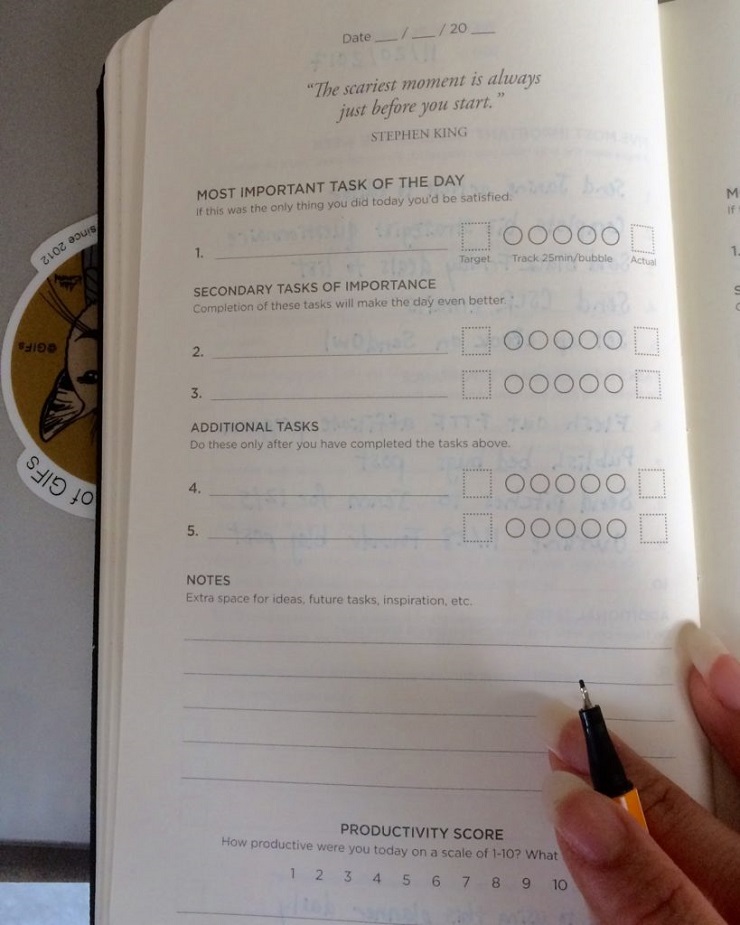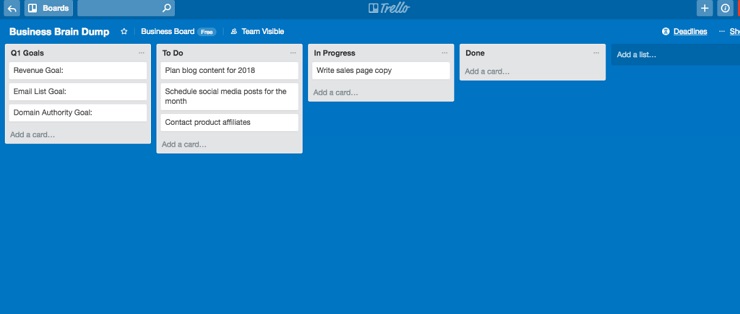There comes a time in everyone’s life when the cost of an unhealthy habit catches up with them and outweighs the benefits of keeping that habit. For me, it was the morning I woke up (in the midst of a health scare, mind you) and discovered that my health insurance had been canceled due to late payment.
The real kicker was I had the money to pay for it—I had just procrastinated and then forgotten to pay the bill. As a result, I was uninsured (for a few hours, anyway. I ended up being able to get it reinstated after making the payments).
My health insurance cancellation was a wake-up call for me: My chronic disorganization and procrastination were not just funny quirks I had become known for—they were severely detrimental habits I could no longer afford to keep. I needed help.
I know for a fact that I’m not alone here, and disorganization impacts the naturally chaotic life of an entrepreneur even more dramatically than most. But if we can overcome these bad habits, we can unlock massive potential for revenue and growth—getting organized is really the only way to scale a business.
So painful and harmful is this state of being that, in 2001, professional organizer Judith Kolberg, after noticing many of her clients were incapable of sticking to organization systems, coined the term “Chronic Disorganization” and launched the National Study Group on Chronic Disorganization (NSGCD).
Now, don’t get freaked out. Chronic disorganization is not a medical diagnosis or an illness; it’s just something many people, including entrepreneurs like you and me, struggle with on a daily basis (you can even fill out this checklist to see if you qualify).
The thing with any bad habit is, we do it because it serves us in some way. Maybe you’ve been getting by in your business (maybe you’re even successful!) even though you pay late fees and let deadlines slip. But the reality is this: It will catch up with you.
My favorite quote that highlights this is from Bill Gates, who said: “The first rule of any technology used in a business is that automation applied to an efficient operation will magnify the efficiency. The second is that automation applied to an inefficient operation will magnify the inefficiency.”
So while you may be able to squeak by with your disorganized ways right now, you will not be able to scale your business with that kind of chaos going on behind the scenes. More sales, more revenue, more growth, will only magnify your inefficiencies.
But take heart! You can change. Here’s how I’m tackling my chronic disorganization and plan to kick it to the curb once and for all.
5 Steps To Conquer Chaos & Get Organized
Step 1: Get to the Root of Your Chronic Disorganization
Before you stock up on all the planners, sticky notes, and fancy apps out there to help you get organized—stop. You need to get to the root of the problem before you even begin to try to tackle it.
This is going to require self-awareness on your part. Before you ask how you’re going to stop being chronically disorganized, you need to ask yourself, “Why am I chronically disorganized?”
Take a few hours one day to sit down and review the past few years of your working life. What kind of feedback have clients and customers given you? What are your strengths and weaknesses? When did you thrive and when did you falter?
- Write down successes you’ve achieved in the past three years of your business.
- Write down failures you’ve experienced in the past three years.
- Can you see a pattern in how your disorganization may have played a part in either your success or failure?
- What specific tasks are you procrastinating or avoiding? Are you doing this because you dislike those tasks?
For me, I realized I thrived when I started having regular clients who assigned editors to my articles. I thrived under their guidance and structured deadlines. I floundered when I had no editor and the deadlines were open-ended.
As for the root of my disorganization problem, I realized that the reason I procrastinate and fail to get organized is that I have so many options and so many “to-dos” that I’m unsure of what to do at any given moment. This causes me to go into decision paralysis and stall on taking an action, or to start and stop so many tasks that I end up getting nothing done.
After you reach a similar clarity about your problem, you need to look at your current systems. What is a business system? It’s simply a pre-established way of doing things in each part of your business to help it run smoothly and operate efficiently.
Here are some common areas of business that commonly fall prey to disorganization:
- Bookkeeping – Do you have a way of keeping track of your expenses? Or do you scramble around at tax time to hunt down receipts?
- Client onboarding – Do you have a process for onboarding new clients? One that can be repeated and even outsourced to a virtual assistant? Or are you manually onboarding your clients in different ways each time?
- Email marketing – Do you have automated sales funnels? Or are you gathering leads only to have them gather dust?
- Reporting and metrics – Do you have a set date each week or month when you pull reports on your finances and other important metrics? Or are you randomly looking at metrics in your business whenever you feel like it, unsure of what it all really means?
- Project management – Do you have a centralized online portal where you and your client can collaborate on projects? Or are your project updates getting lost in a slew of emails, personal notes, and a mix of apps?
In each of those areas, it’s likely that you simply haven’t found a system that works for you.
The good news is now you know where you need help—that’s half the battle. Next, we’ll talk about where you can find that help.
Step 2: Seek Outside Help to Get Organized
If you are noticing symptoms of chronic disorganization and this has plagued you for years or even your entire life, stop kidding yourself into thinking this is something you can solve on your own. It’s time to call in outside help.
Because I realized that I thrive on accountability and that the core of my problem is having too many “to-dos” to actually do anything, I’m taking a two-pronged approach to tackling my own disorganization:
- I hired a business systems strategist. This tackles the accountability problem.
- I am going to outsource all dreaded but necessary business tasks to a virtual assistant. This tackles the procrastination problem.
To understand where and how you might seek outside help, start by asking yourself a few questions.
Do you need a coach or a strategist?
This one stumped me, as I had no idea there was a difference. There is! A coach serves as a sounding board for your ideas. They’ll ask questions and provide encouragement, but ultimately they’ll let you decide which path to take. A strategist, on the other hand, is there to analyze what’s going on and tell you what to do. I preferred hiring a strategist because I felt so lost I didn’t trust myself to figure it out—I wanted recommendations from an expert.
If you’ve decided to hire a coach or a strategist, start looking for recommendations within your own network. For example, I posted a request in a business owners Facebook group I’m in. I detailed exactly what I was looking for, what my issues were, and what my budget was. I got dozens of solid recommendations from people who could vouch for certain strategists they’d worked with.
Do you need to hire someone or do you simply need the right resources?
Rather than hiring a consultant to help you, you can always seek premium resources such as books or online courses.
- If you need help narrowing your focus, The One Thing is a New York Times bestseller that guides readers through a process of eliminating the distractions that keep them from their most important goals. Though not strictly a business book, its principles can certainly be applied to your business.
- For freelancers, Stress Less & Impress is a popular online course that helps you implement systems in your service-based business.
- If you’re short on cash and time, here’s a free online course on how to create a productivity system that’s delivered in five-minute chunks each day.
Whichever way you go will depend on your level of disorganization. For me, I knew I wasn’t going to do well with a self-guided approach. I needed a person there to hold me accountable.
What can you let go of?
We founders can be real control freaks. There’s that old saying, “If you want something done right, you have to do it yourself,” and we really take that to heart.
But here’s the thing: You have to let go of parts of your business if you want to scale. You have to. There is no in-between option.
If you’re stressed out and feeling like you’re drowning beneath your list of to-dos, it’s time to outsource.
Go back to step 1 where you wrote down some business tasks that you’re avoiding because you dislike them—those are perfect opportunities for outsourcing. If you’re not excelling at (or enjoying) doing them, outsource those business tasks to someone else.
Let me give you an example. For one of my clients, I have to write articles based on audio interviews. It takes me about two hours just to transcribe the interviews, but my specialty is not transcription, it’s writing. Why on earth was I wasting hours each month on transcription when I could have outsourced it for $30 a pop?
I’ll tell you why: I didn’t trust anyone else to do it. I figured I’d only end up double checking the contractor’s work, so I might as well do it myself. That’s an extremely limiting belief. There are freelancers out there who specialize in transcription, and here I was being hired for a service I specialized in, only to waste hours on a service I don’t even like.
In the end, I decided it’s best that I outsource it to someone with rave reviews, double check the work for the first couple of times, and then trust them to continue to do well after that.
It’s painful, but every successful founder has had to learn when to relinquish control over a certain area of their business to free them to work on the parts that they excel in.
Step 3: Simplify
Ninety percent of the problem for most disorganized people is that they have too many “priorities.” There’s something really interesting about the etymology of the word “priority.”
In his book Essentialism: The Disciplined Pursuit of Less, Greg McKeown describes how, for centuries, that word was singular—it meant the “first thing,” and there can only be one first thing. Until around the 20th century, when suddenly the plural “priorities” came about, and as you can see, now so many of us have so many “first things” that we’re floundering.
So if you find that you’re rushing around trying to do everything and never getting anything done, or letting things slip through the cracks, it’s likely you have a prioritization problem.
To calm the overwhelm and move the needle for your business, start applying the Pareto, or the 80/20 principle. Which 20% of your efforts is generating 80% of your business income? That’s where you need to apply your focus. Stop chasing everything.
For my blogging business, I reviewed the past 11 months and realized two of my affiliate products make up 78% of my affiliate income. So instead of promoting the other 10+ products I’m an affiliate for, I’ve decided to focus on these two top-performing products to optimize my time. It simplifies my marketing process so I’m not trying to create a marketing strategy for every product, when in reality, those other products only place a drop in the bucket of my affiliate revenue.
So take stock of your business and simplify it by asking these two questions:
- What is my key metric for my business? Is it sales, net profit, pageviews, leads? Pick one metric for success.
- Which 20% of my efforts is contributing to 80% of my success, based on that key metric? The 80/20 comes from the Pareto Principle, but it doesn’t have to perfectly equal 80% and 20%. The point is to optimize your time by focusing only on what’s bringing you the most bang for your buck, so to speak.
Once you simplify your business goals, you’ll be ready to organize in a way that helps you reach them.
Step 4: Organize
All right, you’ve identified the root of your problem, sought outside help, and simplified your business—now you’re ready to get organized!
Here’s my new system (it’s definitely still a work in progress!). Remember, systems work differently for different people. While this works well for me, it may not work for you. Be sure to experiment and play to your strengths!
Productivity Planner: This is where all my daily and weekly business tasks go. The simple act of writing things down has done wonders for my productivity.
Create editorial calendar: If part of your business marketing strategy is content marketing, you’ll need to plan your content for the year. I’ve decided to use the Create editorial planner. This is where all my daily, weekly, and monthly blog tasks go. Because my goal is to increase income from my blog, I’m focusing on content creation for it.
Trello: This is where I brain dump all my ideas, reminders, and tasks and then organize them into what I need to get done and what my VA needs to take care of. It makes it easy to assign cards to certain members of my team.
Virtual assistant: Because I’ve got a growing list of tasks that need to be done to scale my business, I will eventually hire a VA whose job is to take over menial and recurring tasks (such as scheduling social media posts) and remind me of anything I haven’t yet completed as the deadlines approach.
Business systems strategist for accountability and strategy: I also meet with my business systems strategist every two weeks to report to her on my progress.
Remember, play to your strengths. I know from my history that I do really well when I know I will be held accountable by someone in a professional context (in other words, it doesn’t work if the person holding me accountable is my friend; they need to be my “boss” or another professional colleague).
By building accountability into my business organization systems, I am way more likely to hit my goals and meet my deadlines.
Step 5: Review and Repeat
After committing to this process for a significant amount of time, take stock of your progress. If you find the system hasn’t been working for you, it may be time to revise it.
How will you know if a system is a success for you?
Start by asking yourself these questions:
- Are you sticking to the system? It can be the most sophisticated, beautiful system, but if you’re not using it consistently, it’s worthless.
- Are you seeing growth in your key metrics? Revisit what your main goals were for your business and see if there are improvements in them after implementing your new system.
- Do you feel less stressed? This one is a little bit harder to quantify, but if you’ve been meeting important deadlines, feeling better about your business, and sleeping better at night, those are all signs that you’ve probably put a system in place that is working for you.
I’m still in the first month of this new organization system, so I’m sure there are a lot of things that can still be improved.
At the end of the day, remember this: The best system is the one you’ll actually use.
You Can Beat Your Chronic Disorganization
If you’re chronically disorganized, that means this has been going on for years, so it’s not going to resolve itself overnight. Be patient with yourself as you go through the five steps.
- Step 1: Get to the root of your problem
- Step 2: Seek outside help
- Step 3: Simplify
- Step 4: Organize
- Step 5: Review and repeat
While it may be tempting to continue the way things are (after all, you’ve made it this far, haven’t you?), realize that maintaining and scaling are not the same things. If you want to grow your business, you first need to organize your business. Otherwise, you’re just piling inefficiency atop inefficiency.
By organizing your business and implementing systems, you increase your chances of success. You can do this!
What’s one organization hack that helps you stress less?























